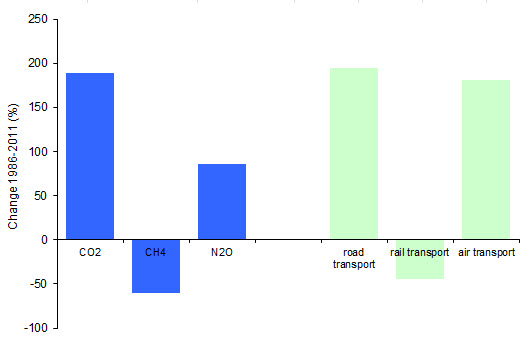-
-
-
-
-
-
-
-
Tools and collections
- Environmental atlas
- EIONET in Slovenia
- Environmental indicators
- IED devices
- Endangered species
- IS-waste

-
-
Tools and collections
- Environmental atlas
- EIONET in Slovenia
- Environmental indicators
- IED devices
- Endangered species
- IS-waste

[PR09] Transport emissions of greenhouse gases

Key message

Greenhouse gas emissions from transport in Slovenia in 2012 increased by 185% compared to 1986. Also in EU GHG emissions from transport are far beyond the growth. In the area of old EU member states in the period 1990-2012 GHG emissions increased by 9% while in the whole EU by 14% (in Slovenia at this time for 111%). Major source of GHGs is road transport which contributed about 99.2% in 2012. Share of transport in GHG emissions (31% in 2012) and not enough effective measures to reduce GHGs make difficulties in achieving commitments of the Kyoto Protocol in Slovenia. Nevertheless, the impact of the recession will help by reaching this goal.
Definition
The indicator shows the greenhouse gas (GHG) emissions from transport in the past. The total emissions are subdivided into road, air, rail and maritime transport. Emissions from international bunkers are not included.
The Kyoto Protocol considers six pollutants from the GHG group; namely carbon dioxide (CO2), methane (CH4), dinitrous oxide (N2O), hydrofluorocarbons (HFC), perfluorocarbons (PFC) and sulphur hexafluoride (SF6). Due to comparability, the GHG amounts are calculated to a CO2 equivalent that considers the differences between the global warming potential of individual gases.
Charts
Greenhouse Gas Emission Database, Slovenian Environment Agency,2014.
Greenhouse Gas Emission Database, Slovenian Environment Agency,2014.
| 0,896630673177161 | 0,104386100588059 | ||
|---|---|---|---|
| change 1986-2012 (%) | % | -60 | 86 |
Annual European Union greenhouse gas inventory 1990 – 2012 and inventory report 2014 – data viewer.
Tajda Mekinda Majaron, Slovenian Environment Agency; Matjaž Česen, Jozef Stefan Institute









